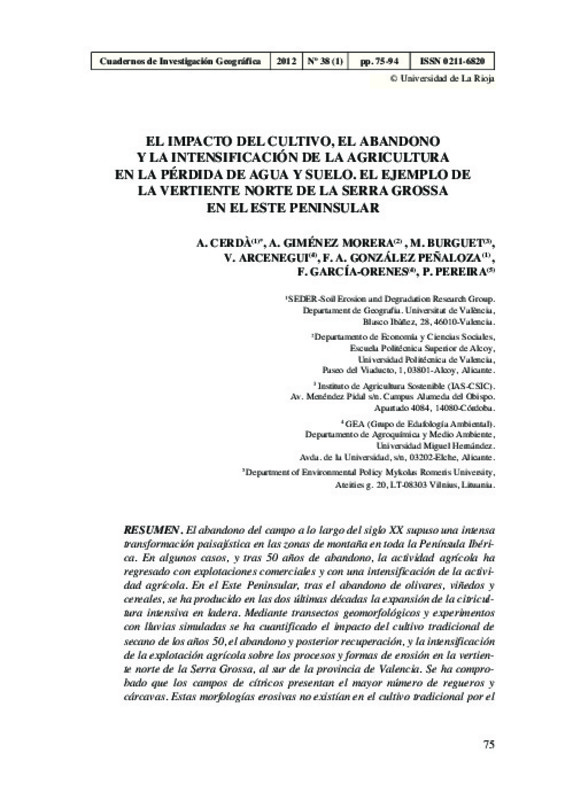JavaScript is disabled for your browser. Some features of this site may not work without it.
Buscar en RiuNet
Listar
Mi cuenta
Estadísticas
Ayuda RiuNet
Admin. UPV
El impacto del cultivo, el abandono y la intensificación de la agricultura en la pérdida de agua y suelo, el ejemplo de la vertiente norte de la Serra Grossa en el este Peninsular
Mostrar el registro completo del ítem
Cerdà, A.; Giménez Morera, A.; Burguet, M.; Arcenegui, V.; González Peñaloza, FA.; García Orenes, F.; Pereira, P. (2012). El impacto del cultivo, el abandono y la intensificación de la agricultura en la pérdida de agua y suelo, el ejemplo de la vertiente norte de la Serra Grossa en el este Peninsular. Cuadernos de Investigación Geográfica. I(38):75-94. https://doi.org/10.18172/cig.1276
Por favor, use este identificador para citar o enlazar este ítem: http://hdl.handle.net/10251/34266
Ficheros en el ítem
Metadatos del ítem
| Título: | El impacto del cultivo, el abandono y la intensificación de la agricultura en la pérdida de agua y suelo, el ejemplo de la vertiente norte de la Serra Grossa en el este Peninsular | |
| Otro titulo: |
|
|
| Autor: | Cerdà, A. Burguet, M. Arcenegui, V. González Peñaloza, F. A. García Orenes, F. Pereira, P. | |
| Entidad UPV: |
|
|
| Fecha difusión: |
|
|
| Resumen: |
[EN] Land abandonment throughout the twentieth century led to an intense landscape transformation in the mountain areas of the Iberian Peninsula. In some cases, and after 50 years of abandonment, agriculture returned with ...[+]
[ES] El abandono del campo a lo largo del siglo XX supuso una intensa transformación paisajística en las zonas de montaña en toda la Península Ibérica. En algunos casos, y tras 50 años de abandono, la actividad agrícola ...[+]
|
|
| Palabras clave: |
|
|
| Derechos de uso: | Reconocimiento - No comercial - Sin obra derivada (by-nc-nd) | |
| Fuente: |
|
|
| DOI: |
|
|
| Editorial: |
|
|
| Versión del editor: | http://dx.doi.org/10.18172/cig.1276 | |
| Código del Proyecto: |
|
|
| Agradecimientos: |
|
|
| Tipo: |
|









